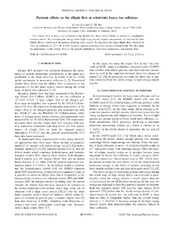| dc.creator | Lin, ZW | |
| dc.creator | Ko, Che Ming. | |
| dc.date.accessioned | 2011-09-13T21:26:11Z | |
| dc.date.available | 2011-09-13T21:26:11Z | |
| dc.date.issued | 2002 | |
| dc.identifier.citation | Z. W. Lin and Che Ming Ko. Phys.Rev.C 65 034904 2002. "Copyright (2002) by the American Physical Society." | en |
| dc.identifier.uri | http://dx.doi.org/10.1103/PhysRevC.65.034904 | |
| dc.identifier.uri | https://hdl.handle.net/1969.1/126917 | |
| dc.description | Journals published by the American Physical Society can be found at http://publish.aps.org/ | en |
| dc.description.abstract | The elliptic flow in heavy ion collisions at the Relativistic Heavy Ion Collider is studied in a multiphase transport model. By converting the strings in the high energy density regions into partons, we find that the final elliptic flow is sensitive to the parton scattering cross section. To reproduce the large elliptic flow observed in Au+Au collisions at roots = 130 A GeV requires a parton scattering cross section of about 6 mb. We also study the dependence of the elliptic flow on the particle multiplicity, transverse momentum, and particle mass. | en |
| dc.language.iso | en | |
| dc.publisher | American Physical Society | |
| dc.subject | NUCLEAR COLLISIONS | en |
| dc.subject | CENTRALITY DEPENDENCE | en |
| dc.subject | J/PSI SUPPRESSION | en |
| dc.subject | PHASE-TRANSITION | en |
| dc.subject | CASCADE MODELS | en |
| dc.subject | PB COLLISIONS | en |
| dc.subject | ENERGY | en |
| dc.subject | SIGNATURE | en |
| dc.subject | FRAGMENTATION | en |
| dc.subject | EQUATION | en |
| dc.subject | Physics | en |
| dc.title | Partonic effects on the elliptic flow at relativistic heavy ion collisions | en |
| dc.type | Article | en |
| local.department | Physics and Astronomy | en |


